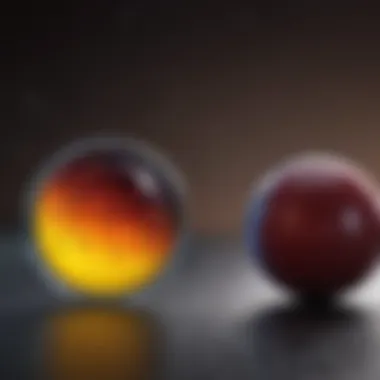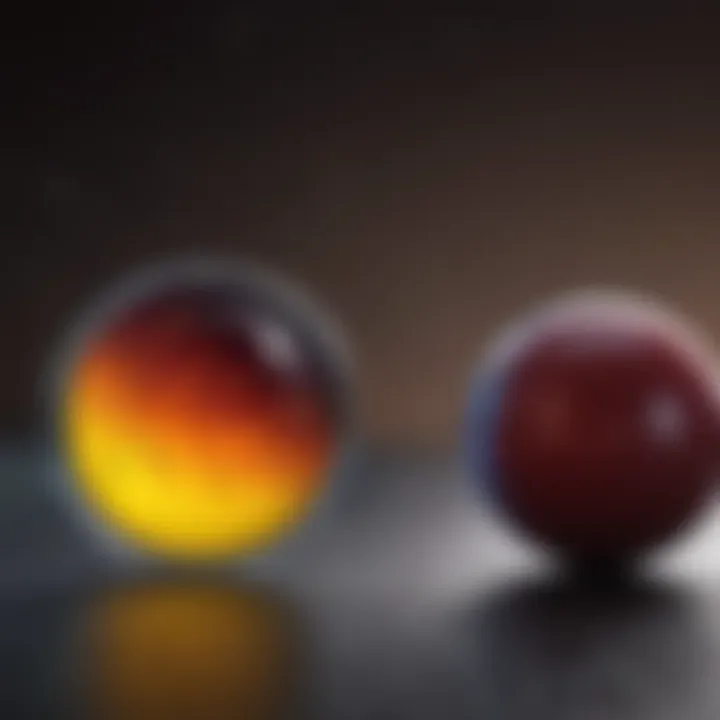Color Reveals: Understanding Color Perception


Intro
Color is an integral part of human experience, influencing how we perceive our environment and affecting our emotions and decisions. This exploration will analyze color perception in depth, weaving through its biological bases and cultural implications. By leveraging recent findings and established studies, we aim to provide a nuanced understanding of how color affects psychology and behavior in various contexts.
Research Overview
Color perception is a complex phenomenon stemming from both biological and psychological factors. Understanding this subject requires a multidisciplinary approach that encompasses aspects of neuroscience, psychology, and art.
Summary of Key Findings
- Biological Underpinnings: The human eye contains photoreceptors, namely cones, that are sensitive to different wavelengths of light. This biological mechanism forms the basis of color vision.
- Emotional Associations: Colors are not just visual stimuli; they evoke emotional responses. For instance, red can signify passion or danger, while blue may induce feelings of calmness.
- Cultural Context: The interpretation of color varies across cultures. For example, white is often associated with purity in Western societies but may represent mourning in some Eastern cultures.
- Applications in Design: Color plays a crucial role in fields like marketing and user experience design, as it can significantly affect consumer behavior and information retention.
Importance of the Research
Understanding color perception is relevant in various fields. From psychology to design, the implications of how colors influence thoughts and feelings are profound. For researchers, this knowledge helps to unravel the intricacies of human cognition.
"Color isn't just how we see the world; it shapes our responses to it."
Methodology
Analyzing color perception also involves examining how research is conducted in this area. Methodology includes various approaches that ensure a comprehensive understanding of the subject.
Study Design
Experiments often involve controlled settings where participants are shown stimuli under different conditions. This can include variations in lighting, background colors, and contexts in which colors are presented.
Data Collection Techniques
Common data collection techniques in color perception research include:
- Surveys and questionnaires about emotional responses to colors.
- Eye-tracking technology to observe visual attention.
- Neuroimaging methods to study brain areas activated by color stimuli.
By dissecting these components, we can foster a more profound appreciation for the role that color plays in shaping human experience. Each study and method contributes to our expansive understanding of how we, as individuals and as a society, interact with color.
Understanding Color: The Science Behind Perception
Understanding color is crucial to grasp how it shapes our experiences and interactions with the world. Colors are omnipresent and affect our emotions, decisions, and behaviors. By exploring the science behind color perception, we can appreciate its significance across various fields, including psychology, marketing, and art.
The study of color begins with its physical properties. Colors arise from light, specifically the wavelengths that are absorbed and reflected by objects. This fundamental interaction gives rise to our perceptions of color. Engagement with this scientific foundation allows us to not only appreciate the aesthetic qualities of color but also understand its implications in daily life.
Beyond physics, the biology of human vision plays a pivotal role in color perception. Our eyes contain specialized cells, namely rods and cones, that capture light and convert it into signals for the brain. This conversion process is remarkable. Understanding how random wavelengths of light become the colors we perceive is essential for research in optics, painting, and even visual technology. Each color has unique emotional connotations, showcasing the interplay between biology and psychology.
In addition, psychophysics examines how we measure perception. Psychophysics explores the relationships between stimulus properties and sensory responses. For example, it can help us quantify how individuals distinguish between similar colors or how color intensity affects emotional response.
This section is integral to our exploration of color because it creates a foundation. We establish a base of knowledge that informs discussions on color psychology, art, design, and technological innovations. Understanding the science behind color is not just academic; it has real-world applications that can influence design choices, marketing strategies, and therapeutic practices.
As we progress through this article, we will connect these scientific principles with practical implications in various domains, enhancing our understanding of color in all its dimensions.
The Physics of Color: Light and Wavelengths
The physics of color centers around light and its interaction with materials. Light travels in waves, and the color we observe depends on the wavelength that reaches our eyes. The visible spectrum ranges approximately from 380 nm (violet) to 750 nm (red).
- Short Wavelengths (e.g., violet): Higher energy, perceived as cooler colors.
- Long Wavelengths (e.g., red): Lower energy, perceived as warmer colors.
This knowledge not only helps in art but also technology. Screens on devices like TVs and smartphones utilize this understanding to render colors accurately.
Human Vision: From Rods and Cones to Color Processing
Our eyes play a crucial role in how we perceive color. Rods and cones are two types of photoreceptor cells within the retina. Rods are sensitive to low light levels and play a role in peripheral vision. Cones, on the other hand, are responsible for detecting color and work best in bright light.
There are three types of cones:
- S-cones (sensitive to short wavelengths)
- M-cones (sensitive to medium wavelengths)
- L-cones (sensitive to long wavelengths)
This trichromatic theory of color vision states that our ability to perceive color arises from the stimulation of these three cone types in different combinations. The brain processes these signals, interpreting them into the wide range of colors we see.
Psychophysics of Color: Measuring Perception


Psychophysics provides insightful methods to measure how we experience colors. Researchers use various approaches to quantify color perception.
- Color Matching Experiments: Participants try to match colors using a limited set of stimuli.
- Threshold Testing: Determining the smallest difference between colors that an individual can discern.
These methods uncover the nuances of how two people might perceive the same color differently. With this understanding, experts can apply psychophysical principles in art, design, and even therapeutic practices.
"The understanding of color is a blend of physics, biology, and psychology, illustrating the multifunctional roles colors play in our lives."
In summary, the science behind color perception forms the backbone of our exploration into broader implications. This section offers a lens through which we can view the vibrancy of colors that surround us.
Color Psychology: Effects on Emotions and Behavior
Color plays a significant role in human emotions and behaviors, making this area of study particularly vital to understanding how individuals perceive and interact with their environment. This section will explore several key elements related to color psychology. Understanding the effects of color can help in various fields such as marketing, design, and mental health.
Research shows that color can impact mood, influencing everything from consumer purchasing decisions to therapeutic practices. By delving into how different colors evoke emotions, we can grasp how individuals relate to specific hues and vibrations. This understanding is essential for educators, marketers, and therapists alike, as it allows them to tailor environments and messages effectively.
Linking Color to Emotion: Theories and Studies
Several theories attempt to explain the emotional effects of color. One widely recognized model suggests that colors have inherent meanings that can evoke specific emotional responses. For example, the color red often symbolizes love and passion, while blue tends to signify calmness and trust. Psychological studies emphasize that these associations are not arbitrary but deeply ingrained in cultural contexts and personal experiences.
Some common findings in studies are:
- Red is linked to heightened arousal and can increase the heart rate, making it ideal for stimulating environments.
- Yellow often represents joy and optimism, which might explain its use in marketing products that aim to sell happiness.
- Green conveys tranquility and is believed to have a restorative effect, which is why it is a popular choice in wellness and therapy settings.
These associations indicate that colors serve as non-verbal cues, creating emotional contexts that can affect daily behavior.
Color Associations: Cultural and Individual Variability
The perception of color is not universal; rather, it is influenced by cultural backgrounds and personal experiences. Different cultures often attribute diverse meanings to the same colors. For instance, white is associated with purity and weddings in Western cultures, while in some parts of Asia, it can symbolize mourning.
This variability highlights the importance of context in understanding color psychology. Personal experiences also shape individual responses to color. Someone might find the color blue calming due to childhood memories, while another might associate it with sadness if it reminds them of loss. Recognizing these cultural and individual differences is essential when applying color psychology in areas like therapy or marketing.
Key points to consider include:
- Personal experiences deeply influence emotional reactions to colors.
- Cultural differences can create varied interpretations of the same hue.
- Adaptations to color use must be tailored to specific audiences for effectiveness.
Practical Applications: Utilizing Color in Therapy
The therapeutic implications of color psychology are gaining attention. Color therapy, also known as chromotherapy, uses colors to influence emotional states and promote healing. This practice integrates the psychological effects of color with traditional therapeutic approaches.
For instance, therapists might use soft shades of green and blue in their offices to create a calming environment. Similarly, warm colors like orange might be used in settings to evoke energy and optimism.
"Color is the keyboard, the eyes are the harmonies, the soul is the piano with many strings." - Wassily Kandinsky
Some practical applications include:
- Selecting colors for therapeutic spaces to enhance mood and comfort.
- Utilizing color in art therapy to facilitate self-expression and promote healing.
- Incorporating colors in educational materials to improve learning and attention.
As color psychology continues to unfold, its implications show significant potential for enhancing emotional well-being and fostering positive interactions.
The Role of Color in Art and Design
Color plays a critical role in art and design, serving as a powerful tool for expression, communication, and emotion. Its application can transform a simple depiction into a profound statement or evoke specific feelings in the viewer. Understanding color's impact in these fields is essential for artists and designers alike, as it influences both perception and interpretation. Color can convey messages, establish mood, and enhance work's aesthetic appeal. It is a construct that goes beyond mere visual experience, integrating psychological and cultural dimensions that must be considered in the creative process.
Historical Perspectives on Color in Art
Historically, color has been key in art since ancient times. Different cultures have used color not only for beauty but to communicate deeper meanings. For instance, in Ancient Egypt, colors had specific associations. The color blue, symbolizing the sky and fertility, played a crucial role in their art. Similarly, during the Renaissance, artists like Leonardo da Vinci explored the interplay of light and color, leading to more realistic representations. These historical contexts show that color is not just an aesthetic choice; it reflects cultural significance and societal values.
Art movements also shaped the understanding of color. Impressionism, for example, emphasized natural light and its effect on color. Artists like Claude Monet captured fleeting moments with vibrant hues, influencing how viewers perceive time and mood in art. Such movements encourage artists to experiment with color, pushing boundaries of expression and perception. Historical analysis of color allows for a deeper appreciation of its evolution and conveys its importance in continued artistic innovation.
Modern Color Theory: Principles and Practices
Modern color theory emerged from the study of primary colors, secondary colors, and color mixing. The principles of harmony and contrast are crucial in design, guiding artists in their choices. The color wheel, developed by Isaac Newton and further refined by artists, serves as a visual guide for understanding relationships between colors. This tool aids in creating palettes that evoke desired emotional responses.
Color can also influence physical space. A well-chosen color scheme can make a small room appear larger or convey warmth. Designers often incorporate warm and cool colors to achieve specific moods in interiors. For those in graphic design, color usage impacts branding and user experience. A clear grasp of color theory allows creators to make informed decisions, enhancing the overall aesthetic and functional quality of their work.
Color in Branding: The Psychological Impact


In branding, color influences consumer perception significantly. Different colors evoke specific feelings and associations. For example, blue is often linked with trust and reliability, making it a popular choice for corporate branding. Red can evoke excitement or urgency, common in food marketing, like Coca-Cola.
Understanding the psychological impacts of color can lead to better marketing strategies. Brands must consider their target audience's cultural backgrounds and preferences regarding color associations. Often, colors are not universally interpreted; bright colors may be seen as playful in one culture while perceived as overwhelming in another.
By leveraging color psychology, brands can align their visual identity with their core values and communicate effectively with consumers. Calculated choices can help create an emotional connection, influencing buying behavior and loyalty.
"Color is the keyboard, the eyes are the harmonies, the soul is the piano with many strings." – Wassily Kandinsky
Understanding how color interacts with art and design can help elevate creative expression and enhance communication in various contexts. As artists and designers continue to explore the role of color, they contribute to a rich dialogue about its impact, ensuring it remains a vital element in shaping culture and society.
Color in Nature: Biological Significance
Color in nature plays a critical role in the survival and functioning of various species. It is not just a visual phenomenon but also a vital biological signal that impacts behavior and adaptation. Understanding the biological significance of color helps clarify how species interact with their environment and each other.
Coloration in Animals: Communication and Survival
Animal coloration can serve multiple purposes, including camouflage, signaling to potential mates, and deterring predators. For example, many species possess coloration that allows them to blend into their surroundings, thus avoiding detection. This tactic is crucial for survival, especially in prey species.
On the other hand, some animals use bright colors to attract mates. The vivid plumage of a male peacock is a prime example of this. Their bright feathers signal health and vitality, which are appealing qualities for a potential mate. Additionally, certain colors can signal danger; for instance, the bright color patterns seen on many venomous species serve as warnings to predators.
"Coloration not only enhances survival but also plays a pivotal role in reproduction among many species."
Plant Coloration: Attraction and Repulsion
Plants have evolved diverse colorations to attract or repel various organisms. Brightly colored flowers, like those of tulips and sunflowers, lure pollinators such as bees and butterflies. These colors play a significant role in the reproductive cycle of plants, as successful pollination leads to seed production and species propagation.
Conversely, some plants have developed more muted or less attractive colors to avoid herbivores. These strategies demonstrate the importance of color in the intricate web of ecological interactions, emphasizing its role in both attraction and repulsion.
Evolution of Color Perception among Species
The evolution of color perception differs significantly among species and is influenced by lifestyle and environment. Some species, like certain insects, can detect ultraviolet light, which is invisible to humans. This capability allows them to see patterns on flowers that guide them to nectar, showcasing the evolutionary advantage of advanced color perception.
Other species, especially nocturnal animals, have adapted to perceive color in low-light conditions. These adaptations underline how varying environments shape the evolution of color perception, allowing species to thrive despite the challenges posed by their habitats. The biological significance of color in nature thus lies in its multifaceted role—adaptation, reproduction, and survival.
Color Technology: Innovations and Applications
Color technology represents a vital intersection of science, art, and practical applications. Its significance within this article lies in the way it encapsulates advancements that enhance our understanding and utilization of color. Color technology impacts various sectors, diving into areas such as design, manufacturing, and communication. Understanding the tools and techniques that come under this umbrella can very much change our routine interactions with color.
Digital Colorimetry: Tools and Techniques
Digital colorimetry is a field that focuses on the measurement and analysis of color in a digital format. It involves using specialized tools like colorimeters and spectrophotometers to quantify colors accurately. These devices capture data that can be crucial in achieving color consistency across productions. In fields like graphic design and photography, precise color reproduction is essential.
Tools such as Adobe Color and Pantone extend the functionality of colorimetry by enabling digital manipulation of colors. They allow creators to explore color palettes and experiment with hues, shades, and tones effectively. The ability to identify color values can help artists and designers in ensuring their visions are realized without compromises.
Color in Information Transfer: Significance and Methods
The role of color in information transfer is profound. Colors can serve as quick identifiers in charts and infographics. They can change the way information is perceived and processed by the audience. For instance, red may indicate urgency or importance, while blue can symbolize calmness and trust.
Methods of using color for information transfer include:
- Color coding: A technique used to indicate different categories or statuses.
- Contrast utilization: Helps in highlighting data and ensuring readability.
- Visual hierarchy: Colors can imply importance, leading the viewer's eye to critical information first.
All these techniques enhance data comprehension when used thoughtfully. Their implementation is instrumental in fields such as education, marketing, and user interface design.
Emerging Technologies: Artificial Intelligence and Color
Artificial intelligence is transforming color technology in ways that were not previously conceivable. AI can analyze vast data sets to predict color trends and preferences for products. This capability helps businesses in tailoring their offerings to suit consumer tastes more keenly.
Moreover, applications such as color recognition software are becoming more advanced. These systems can identify colors in real time, which is useful in various contexts like fashion, interior design, and manufacturing.
Furthermore, AI algorithms can generate color palettes that complement existing designs, significantly enhancing creative processes. These innovations not only streamline workflows but also allow for greater experimentation with color in modern design and marketing strategies.
"Color technology is not just a tool but an essential facilitator in how information is presented and understood".
In closing, color technology offers numerous innovative applications that resonate across disciplines. From digital colorimetry tools to the integration of AI, each component plays a decisive role in how we perceive and use color in a tangible sense.
Theoretical Perspectives: The Nature of Color


Understanding the nature of color is fundamental to unraveling its implications across various disciplines. This section focuses on theoretical frameworks that inform our comprehension of color perception. By examining philosophical, scientific, and psychological theories, we gain valuable insights into how color is not simply a visual experience but also a complex interplay of physical properties and cognitive interpretations. Color is essential in areas ranging from art and design to mental health and environmental policy.
Philosophical Analysis of Color Perception
Philosophy offers a critical lens through which we can analyze our understanding of color. Philosophers have debated whether color exists as a property of objects or as something perceived by the observer. This leads to two primary views: realism and idealism regarding color attributes. Realists maintain that colors are inherent to objects, while idealists argue that color depends on perception.
In addition, discussions about "qualia"—the subjective experience of color—further enrich our philosophical discourse. Questioning how and why perceptions of color differ among individuals can reveal much about human consciousness. The implications of these philosophical inquiries extend to areas such as ethics, aesthetics, and the philosophy of mind. Understanding these perspectives invites deeper reflections on how we interact with the colorful world around us.
Neuroscience of Color: Brain Processing Mechanisms
Neuroscience provides empirical insights into how the brain processes color. The mechanisms of color perception begin with the interaction of light with photoreceptors in the retina, particularly the cones that are sensitive to different wavelengths. From the retina, signals travel to various brain areas responsible for interpreting color.
Key areas involved in color processing are:
- Visual Cortex: This area is critical for interpreting color data. It helps distinguish colors and recognizes patterns.
- Ventral Pathway: Often called the "what pathway," this area aids in identifying objects and their colors within our visual field.
- Color Constancy Mechanisms: These processes ensure that colors appear relatively constant under varying lighting conditions, indicating a robust brain function.
Understanding the neural basis of color perception not only elucidates how we experience color but also highlights potential areas for research, such as in neurological disorders where perception might be altered. The interplay between perception and brain mechanisms invites further investigation into how colors impact our behavior and interactions.
Color and Its Societal Implications
In exploring the intersection of color and society, one must acknowledge the profound role that color plays in shaping human experiences and interactions. Colors are not merely visual phenomena; they carry a weight of meaning and influence that extends into emotions, culture, and communication. This section examines such implications and emphasizes the need to understand how color can be a silent but powerful force in various contexts.
Color in Social Interactions: Non-Verbal Cues
Color influences social interactions significantly. Non-verbal cues, including color, convey emotions and societal roles. For instance, the color red is often associated with excitement or passion. In contrast, blue can imply calmness or trust. People are naturally adept at picking up these cues, often without conscious awareness. When dressed in colors that align with their intended messages, individuals can facilitate more effective communication.
- Warm Colors (like red, orange, and yellow) tend to evoke feelings of warmth and positivity.
- Cool Colors (like blue, green, and purple) are usually perceived as calming or soothing.
For example, in settings like job interviews or business meetings, the choice of color can influence perceptions of authority and reliability. Consequently, individuals often select colors carefully to align with their social objectives.
Cultural Meanings of Color: A Global Perspective
Colors carry diverse meanings across different cultures. Understanding the cultural significance of colors is vital for effective communication and interaction. For instance:
- In Western cultures, white symbolizes purity and peace, often used in weddings.
- Conversely, in some Eastern cultures, white is associated with mourning and death.
Such differences highlight the potential for misunderstandings when color choices are made without cultural context. For professionals dealing with international audiences, sensitivity to these cultural variations is crucial.
Color Legislation: Regulations in the Public Sphere
The implications of color extend into policy and legislation. Regulating color usage in public spaces impacts societal mood and behavior. Examples include traffic light colors, which have standardized meanings—red for stop, green for go, and yellow for caution. Furthermore, color legislation can also influence marketing in public promotions. Laws might dictate which colors can be used in advertisements, aiming to uphold certain societal standards or protect public health.
Understanding these regulations provides insight into how color can shape public perception and actions. Professionals working in urban planning or public policy should be aware of the roles colors play to ensure that designs align with societal values and enhance community interactions.
"Colors provoke emotional responses that significantly influence individual and collective behaviors."
Future Directions in Color Studies
The exploration of color and its implications is an ever-evolving field. It holds the potential to bridge various disciplines, revealing insights that can improve our understanding of both the natural and social worlds. As the landscape of color studies expands, future research should integrate diverse perspectives and methodologies. Embracing interdisciplinary collaboration can create robust frameworks that not only advance theoretical perspectives but also yield practical applications.
Interdisciplinary Approaches: Bridging Science and Art
Interdisciplinary approaches in color studies are essential for revealing the depths of color perception. By combining insights from psychology, neuroscience, art, and technology, researchers can build a comprehensive understanding of how color influences human behavior and creativity.
- Psychology: Investigating how color affects mood and cognition.
- Neuroscience: Exploring the pathways through which color information is processed in the brain.
- Art: Utilizing color theory in design and visual arts to evoke specific emotional responses.
- Technology: Leveraging digital tools to analyze color perception in real-time applications.
This rich interplay of fields can lead to innovative findings applicable across various sectors, from marketing strategies to therapeutic interventions. Thus, the synergy between science and art emerges not only as an academic endeavor but as a practical toolkit useful in real-world settings.
The Role of Color in Global Challenges: Climate Change and Health
Color also serves a crucial function in addressing pressing global challenges. Climate change and public health are two domains where color perception can provide unique insights. For instance, colors predict weather patterns and environmental changes. Understanding how different hues signify various climate-related phenomena can enhance communication strategies for climate action.
Moreover, in health communication, color can significantly impact public understanding of health risks. For example, using specific colors in informational graphics can alert individuals to health hazards effectively. This is particularly relevant in public health campaigns where recognition and response are critical. Therefore, integrating color studies into strategies targeting climate change and health can foster more effective communication and action.
Innovative Research: New Frontiers in Color Science
Looking ahead, innovative research in color science is poised to unlock new frontiers. Advances in technology offer tools for more precise measurement and analysis of color perception. Consider the potential of artificial intelligence in delineating how different color combinations impact decision-making and emotional response.
Research focuses include:
- Color and AI: Utilizing algorithms that can interpret color preferences and perceptions on a large scale.
- Virtual reality: Examining how virtual environments utilize color to create immersive experiences.
- Biomimicry: Borrowing from nature’s color schemes for innovative design solutions that promote sustainability.
As these avenues develop, they will enrich our understanding of color’s role in our lives, further compelling us to acknowledge its importance in both scientific and artistic contexts. The future of color studies has the potential to be as vibrant and multifaceted as color itself.



